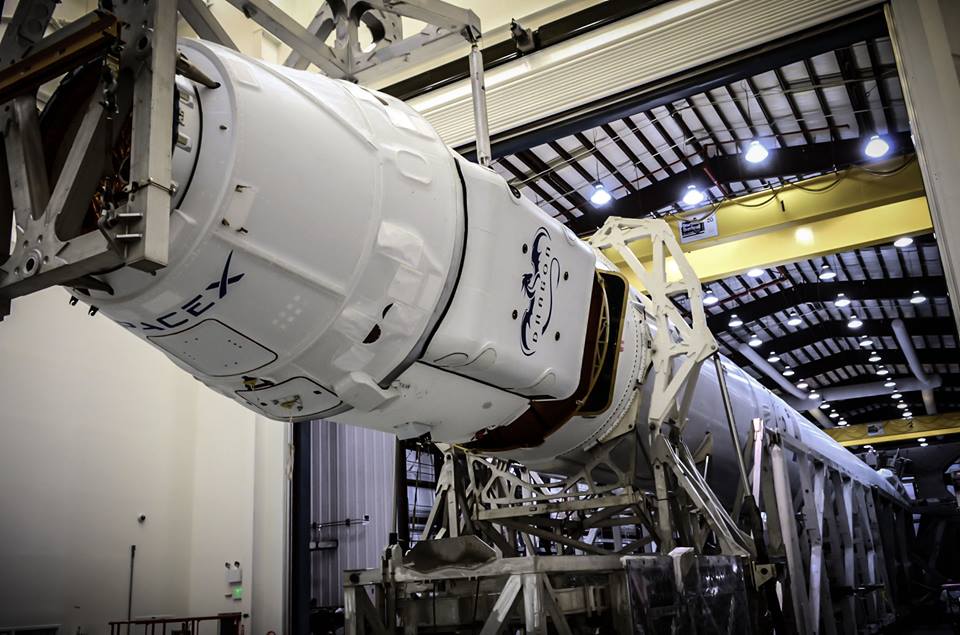
A second launch in just four days is scheduled to take place from Cape Canaveral Air Force Station, Fla., when SpaceX launches its third dedicated Dragon cargo delivery mission to the International Space Station (ISS). Liftoff of the two-stage Falcon 9 v1.1 rocket—on its first mission with a Dragon and only its fourth flight in total—is scheduled to occur at 4:58:44 p.m. EDT Monday, 14 April. As with previous SpaceX flights, the launch will occur “instantaneously,” hence the specific timing. SpaceX mission managers officially declared that they were “Go for Launch” at the conclusion of the Launch Readiness Review on Friday afternoon. The failure of a backup Multiplexer-Demultiplexer (MDM) on the space station’s Mobile Base System (MBS), also on Friday, has led to a decision to stage a contingency EVA (designated “U.S. EVA-26”) as early as Tuesday, 22 April. However, the MDM failure and EVA-26 planning is not expected to interfere with tomorrow’s planned CRS-3 launch.
According to NASA, the failed MDM is one of more than a dozen housed on the ISS truss structure. It is responsible for routing commands to various systems on the station’s inboard truss structure, including the cooling system, radiators, and the MBS. Friday’s failure occurred during a routine health check of the EXT-2 box, which provides backup capability to a prime component on the central S-0 truss. Attempts to reboot the MDM have shown little sign of improvement to date, and Mission Control is considering the component as lost. Although its prime sibling continues to function normally, and there has been no disruption to ongoing station operations, it was feared that this reduction of backup capability eliminated its “fault-tolerant redundancy.”
Early Sunday, engineering teams evaluated whether the ISS carried sufficient redundancy to permit the CRS-3 launch to proceed as planned on Monday. “The station’s Canadarm2 robotic arm that would be used to capture and berth Dragon has other redundancy capabilities not affected by the backup MDM failure,” NASA explained. “While a final decision on the SpaceX launch is being reviewed, another team of engineers is laying out a timeline for a contingency spacewalk that is required to replace the failed spare MDM.” NASA added that an MDM removal and replacement forms part of one of the so-called “Big 12” spacewalk tasks which ISS crews train to perform in order to hedge against the loss of critical station components. According to ISS Program Manager Mike Suffredini, an MDM changeout is one of the simplest and least complex of the Big 12 EVA tasks.
Although the Canadarm2 command path is unaffected by this problem, it was pointed out by Spaceflight101 that “redundancy in certain systems is a requirement for ISS operations” and that the station “requires a redundant control path of the robotics to ensure a safe grapple of the [Dragon] spacecraft by the station’s robotic arm.” Last night (Saturday), NASA decided to press on with forward planning for an imminent EVA, and Mr. Suffredini confirmed Sunday that EVA-26 would occur as soon as 22 April. This is partly due to the planned undocking of the Progress M-21M cargo craft from the Russian segment on 23 April for two days of Kurs-NA (“Course”) navigation system tests, followed by a redocking on 25 April.
Mr. Suffredini also added that a decision will be made later Sunday on which two members of the U.S. Orbital Segment crew—Koichi Wakata, Rick Mastracchio, and Steve Swanson—would perform EVA-26. Wakata is presently Expedition 39 Commander, although he has never performed a spacewalk. Mastracchio, with eight EVAs under his belt, is currently the sixth most experienced spacewalker in the world, with a cumulative total of 51 hours and 28 minutes. Swanson, who arrived last month, has four EVAs from earlier missions to his credit and a total of 26 hours and 22 minutes working in the vacuum of space. Other media outlets, including NASASpaceflight.com, have suggested that EVA-26 may last about three hours. If Mastracchio is selected to participate in EVA-26, a three-hour excursion would push him into fifth place on the list of the world’s most experienced spacewalkers, pipping Russian cosmonaut Fyodor Yurchikhin, whose cumulative total currently stands at 51 hours and 53 minutes.
Saying that the Mission Management Team was “in a very good posture for the EVA,” Mr. Suffredini said that assessments have shown that Extravehicular Mobility Units (EMUs) No. 3011 and No. 3005 had been selected to support the upcoming EVA. The 3011 suit made the headlines in July 2013, when Luca Parmitano suffered water intrusion into his helmet in the early stages of EVA-23. Following an extensive investigation and corrective actions, both it and 3005 have been equipped with replacement fan pump separators. Another fan pump separator is flying aboard CRS-3 to be installed in EMU No. 3010, the third U.S. space suit currently in residence aboard the ISS.
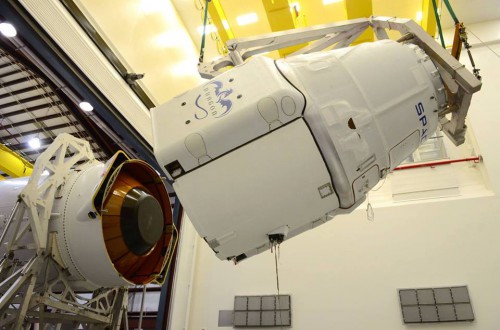
The CRS-3 mission is the third under SpaceX’s $1.6 billion Commercial Resupply Services contract with NASA, which calls for 12 cargo flights to supply a total of 44,000 pounds (20,000 kg) of equipment and supplies to the station by 2016. It comes in the aftermath of Dragon’s inaugural test flight to the ISS in May 2012 and the CRS-1 and CRS-2 missions in October 2012 and March 2013. This mission will sport an upgraded power and cargo capability for Dragon, as well as demonstrating the ability of the Falcon 9’s first stage to perform an ocean splashdown on extendible landing legs.
In the immediate aftermath of the CRS-2 mission last March, it was anticipated that CRS-3 would fly in the September-November timeframe, although this quickly became December as the schedule of U.S. visiting vehicles morphed to accommodate changing conditions. By August, both CRS-3 and the first dedicated Cygnus cargo flight by Orbital Sciences Corp. (ORB-1) were accommodated within the same December “launch window” and SpaceX accepted to postpone their mission until January 2014. By the end of the year, with ORB-1 itself delayed until January, this date had moved to no earlier than 22 February, which soon shifted to early March and finally settled on the 16th. A successful hot-fire test of the nine Merlin-1D first-stage engines on the Falcon 9 rocket was conducted at the Cape’s Space Launch Complex (SLC)-40 in the days preceding the opening launch attempt, but SpaceX notified NASA that it would postpone the mission for a further two weeks.
Citing its desire for “the highest possible level of mission assurance and allow additional time to resolve remaining open issues,” the Hawthorne, Calif.-based company, headed by entrepreneur Elon Musk, explained that it was now tracking 30 March as its next available launch date. In the aftermath of the delay, SpaceX President and Chief Operating Officer Gwynne Shotwell explained that the company was working up to four issues. “We were struggling on some buffering data-transfer with Houston,” Shotwell stated, as explained in an article by AmericaSpace’s Emily Carney. “We wanted a little more time to work with the range on trajectory. We are going to try to do some re-entry and landing burns on the first stage. My operations crew was in a time crunch for Dragon, which is a very new Dragon. Finally, we did notice stains on the impact shielding.” This staining was caused by “oil contamination from the manufacturing process,” which left “regular patterns” on beta-cloth shields within Dragon’s unpressurized Trunk. “It didn’t show up right away when the blankets were manufactured,” Shotwell continued. “Luckily, our pre-encapsulation checks caught it.” After assessments, it was decided that the level of contamination was acceptable.
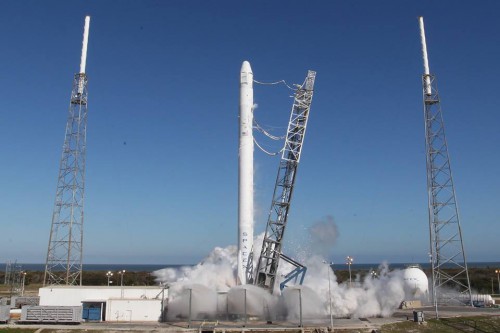
A launch on 30 March also became untenable, when the Eastern Range—which monitors all missions originating from the East Coast—suffered an electrical short and a fire in a critical radar tracking asset which impacted the TEL-4 Telemetry Processing Facility, part of the Eastern Space and Missile Center (ESMC). “Inspections conducted by the U.S. Air Force that operates the Eastern Range and all of its assets revealed that extensive equipment replacements were needed to bring the radar station back online,” explained Spaceflight101, “a process that would take weeks, because there no backup components were available and had to be ordered to the Cape before being installed.”
With United Launch Alliance (ULA) also scheduled to fly its Atlas V rocket from the Cape’s SLC-40 complex on a mission to deliver the classified NROL-67 payload into orbit for the National Reconnaissance Office, both missions were put on hold as a solution was identified. At length, with the problem rectified, it was decided that since NROL-67 was on the Range first, it would be granted the next available launch opportunity, and the Atlas V successfully rocketed its top-secret cargo into orbit on Thursday, 10 April. Meanwhile, SpaceX accepted a “window” between 14-18 April in order to achieve favorable phasing for Dragon’s rendezvous profile with the ISS.
Flying on the heels of the Commercial Orbital Transportation Services (COTS) test mission and the CRS-1 and CRS-2 dedicated flights, this will be the fourth Dragon to undertake the journey to the space station, which is presently staffed by the six-man Expedition 39 crew. Commanded by Koichi Wakata, the first Japanese to lead a space mission, the crew also includes Russian cosmonauts Mikhail Tyurin, Aleksandr Skvortsov, and Oleg Artemyev and U.S. astronauts Rick Mastracchio and Steve Swanson.
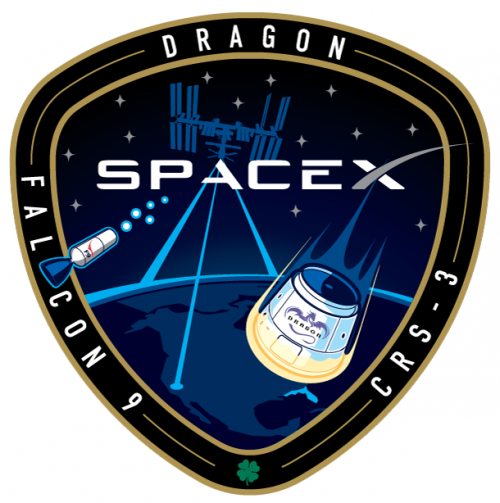
SpaceX received the $1.6 billion CRS contract from NASA in December 2008 and is tasked with staging 12 cargo missions by 2016. According to NASASpaceflight.com, three Dragons (CRS-3, 4, and 5) are scheduled for launch this year, in April, August, and November, followed by as many as four in 2015 and the final flights in 2016. However, judging from the delays to which CRS-3 has fallen victim, it seems likely that there will be some slippage to these targets. Nevertheless, SpaceX has continued to move from strength to strength, not only with Dragon itself, but also with the upgraded Falcon 9 v1.1 launch vehicle, which undertook its maiden voyage in September 2013 and has since delivered its first two geostationary payloads into orbit: the SES-8 communications satellite in December and the Thaicom-6 communications satellite in January.
All previous Dragon missions were launched by the earlier Falcon 9 v1.0 vehicle, and Monday’s mission will mark the first occasion on which an ISS cargo craft has been lofted atop the new configuration. The new rocket’s enhanced performance means that CRS-3 has the capability to transport a record-sized payload of almost 5,000 pounds (2,270 kg) to the station. “Dragon got a few upgrades since its last trip to station,” explained SpaceX on its Facebook page. “To support the more critical science payloads for the ISS, the spacecraft … has nearly quadrupled its previous powered cargo capability. Dragon will carry additional freezers in its pressurized section and, for the first time ever, powered cargo inside its unpressurized Trunk … The spacecraft is also sporting redesigned cargo racks to accommodate the additional payloads.”
One of the freezers is a powered General Laboratory Active Cryogenic ISS Experiment Refrigerator (GLACIER), which provides for the transportation and preservation of biological and other samples at temperatures between -160 degrees Celsius (-301 degrees Fahrenheit) and 4 degrees Celsius (39 degrees Fahrenheit). Dragon will also carry a pair of Microgravity Experiment Research Locker Incubators (MERLINs), both of which will supply a refrigerator/incubator at temperatures from -20 degrees Celsius (-4 degrees Fahrenheit) to 48.5 degrees Celsius (119 degrees Fahrenheit).
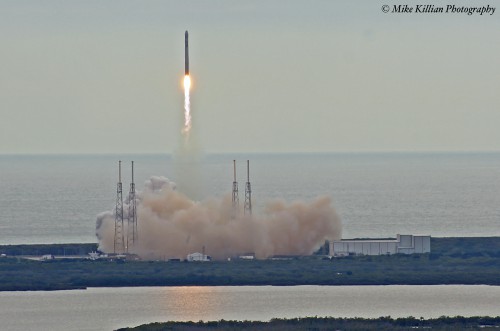
Powered cargoes inside the unpressurized Trunk include the Optical Payload for Lasercomm Science (OPALS) to demonstrate high-bandwidth space-to-ground laser communications and the High-Definition Earth Viewing (HDEV) quartet of commercial HD video cameras to film Earth from multiple angles. Both of these payloads will be robotically installed onto the exterior of the ISS. Also aboard the vehicle will be a new Extravehicular Mobility Unit (EMU) space suit to replace the unit which malfunctioned and allowed water seepage into the helmet area during Luca Parmitano’s ill-fated EVA-23 in July 2013. The problematic suit will be returned to Earth aboard Dragon.
As is standard before Falcon 9 launches, the vehicle underwent a static “hot-fire” test of the nine Merlin-1D first-stage engines last month. Ahead of Monday’s opening launch attempt, the nine engines will commence their ignition sequence at T-3 seconds, steadily ramping up to 1.3 million pounds (590,000 kg) of thrust. This is about 200,000 pounds (90,000 kg) greater than the propulsive yield of the Falcon 9 v1.0, which delivered previous Dragons into orbit. The Merlin-1Ds will push the vehicle uphill for 180 seconds, their thrust gradually rising during ascent to 1.5 million pounds (680,000 kg) in the rarefied high atmosphere. “Unlike airplanes, a rocket’s thrust actually increases with altitude,” noted SpaceX. “Falcon 9 generates 1.3 million pounds of thrust at sea level, but gets up to 1.5 million pounds of thrust in the vacuum of space. The first-stage engines are gradually throttled near the end of first-stage flight to limit launch vehicle acceleration as the rocket’s mass decelerates with the burning of fuel.”
Immediately after clearing the SLC-40 tower, the Falcon 9 v1.1 will execute a combined pitch, roll, and yaw program maneuver to establish itself onto the proper flight azimuth for the injection of Dragon into low-Earth orbit. Eighty seconds into the ascent, the vehicle will pass Mach 1 and experience a period of maximum aerodynamic stress (known as “Max Q”) on its airframe. The Merlin-1Ds will continue to burn hot and hard, finally shutting down at T+3 minutes, and the first stage will be jettisoned about five seconds later.
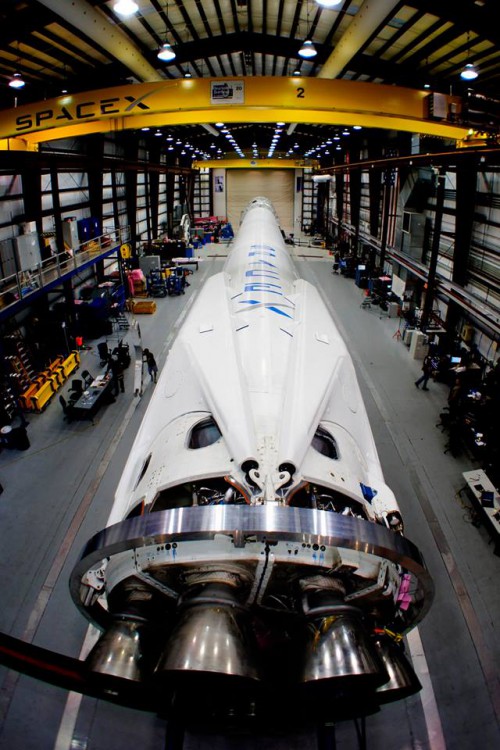
This launch is indicative of the steady maturity of SpaceX technology, as it strives to develop a fully reusable Falcon 9, whose two stages will ultimately be able to complete their respective boost phases, propulsively return over water, and touch down on extendable landing legs back at their launch site. The system was trialed, with mixed results, during the inaugural flight of the Falcon 9 v1.1, last 29 September, but it experienced an uncontrollable roll during its descent. This caused the final burn of the center Merlin-1D engine to be shortened, due to the centrifuging effect on propellant against the tank walls, which damaged the baffles and allowed debris to enter the engines. Landing legs were not flown aboard the second Falcon 9 v1.1 mission, which launched the SES-8 communications satellite in December, or aboard the third mission, which launched Thaicom-6 in January.
The Falcon 9 assigned to the CRS-3 mission boasts four fold-out landing legs, made from carbon-fiber and aluminum honeycomb, on its first stage, which will be deployed during the controlled descent. Although a touchdown on land is not yet planned, SpaceX hopes to touch down on water. Shortly after the burn-out and separation of the first stage, it will execute a maneuver with its cold-gas attitude-control system to establish an “engine-forward” orientation. Three of the nine Merlin-1Ds will briefly fire to effect braking during the re-entry process, and the four landing legs will be deployed using high-pressure helium once in atmospheric flight. The legs span 60 feet (18 meters) when fully deployed, and the entire assembly weighs about 4,400 pounds (2,000 kg).
Assuming that the vehicle does not again fall victim to excessive roll motions, the center Merlin-1D will ignite shortly before it makes a gentle impact with the Pacific Ocean. Elon Musk has stressed that although an attempt will be made to retrieve the first stage from the ocean, the system remains experimental in nature and he does not anticipate success for at least the first several attempts. This “experimental” note was made repeatedly at today’s conference by Dr. Hans Koenigsmann, SpaceX Vice President of Mission Assurance, who pointed out that he expected only a 40-percent chance of success in this “really difficult maneuver.” Dr. Koenigsmann added that SpaceX would be “super-thrilled” if they accomplish a successful entry burn, let alone a successful ocean touchdown.
Meanwhile, with the first stage gone, the turn will come for the Falcon 9 v1.1’s restartable second stage, whose single Merlin-1D Vacuum engine—with a thrust of 180,000 pounds (81,600 kg)—will fire to deliver Dragon into a low-Earth orbit of 202 x 202 miles (325 x 325 km), inclined 51.54 degrees to the equator.
Following separation from the vehicle, the resupply craft will unfurl its electricity-generating solar arrays, deploy its Guidance and Navigation Control (GNC) Bay Door to expose critical rendezvous sensors, and begin a complex series of maneuvers to reach the ISS. It will approach the station along the so-called “R-Bar” (or “Earth Radius Vector”), which provides an imaginary line from the center of Earth toward the ISS, effectively approaching its quarry from “below.” In so doing, Dragon will take advantage of natural gravitational forces to provide braking for its final approach and reduce the overall number of thruster burns it needs to perform.
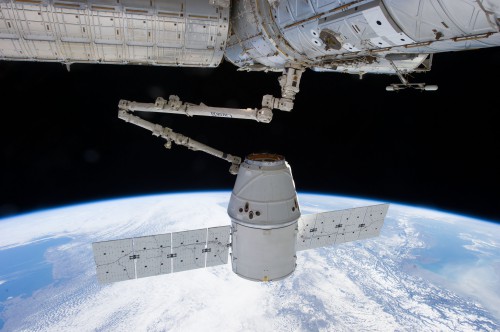
By the third day of autonomous operations, it will have drawn into the vicinity of the space station and several “Go/No-Go” polls of flight controllers will permit it to gradually reduce its distance to about 30 feet (10 meters), placing it within range of the 57.7-foot (17.4-meter) Canadarm2 robotic arm. The spacecraft will then be captured by the incumbent Expedition 39 crew and berthed onto the Earth-facing (or “nadir”) port of the Harmony node. Berthing is anticipated about 38 hours after liftoff. Assuming an on-time launch Monday, it is anticipated that Dragon will be grappled by Canadarm2 at about 8 a.m. EDT Wednesday, 16 April, and berthed shortly afterward.
Following berthing, it is expected that Dragon will remain attached to the ISS for about a month. Orbital Sciences Corp.—NASA’s other Commercial Resupply Services partner—recently noted that Dragon “has a minimum 28-day stay requirement.” This almost certainly means that Orbital’s second dedicated Cygnus cargo mission (ORB-2), previously scheduled for launch on 6 May, will be delayed, because both spacecraft utilize the Harmony nadir interface. How long remains to be seen, for Soyuz TMA-11M is scheduled to depart on 14 May and a new crew will arrive aboard Soyuz TMA-12M on the 28th. Coupled with a subsequent solar beta angle cut-out, the next available date proposed by NASA for Orbital would be sometime after 9 June. “In the meantime,” Orbital stressed, “as a risk-reduction effort for our NASA customer, the ORB-2 team continues to work to be able to meet the 6 May launch capability, if needed.”
Monday’s weather forecast currently predicts an 80-percent probability of acceptable conditions for the CRS-3 launch, with the primary concerns classified as a possible infringement of the Anvil Cloud Rule. Should the mission not fly on Monday, the meteorological situation is expected to deteriorate later in the week. In Sunday’s media update, Mike McAleehan, Launch Weather Officer with the 45th Weather Squadron, noted that heavy cloud cover over the Cape Canaveral area is anticipated on Tuesday and only a 40-percent likelihood of acceptable conditions by Friday, due to thick clouds and risk of precipitation.
Want to keep up-to-date with all things space? Be sure to “Like” AmericaSpace on Facebook and follow us on Twitter: @AmericaSpace
Missions » ISS » COTS » CRS-3 »



Ben,
Great article…This is exciting on the reuseability aspect…Hopefully important knowledge is gained from today’s launch and soon they will be landing the first and second stages back at the Cape!!! This is very encouraging in the quest to lower launch cost.
Not today, guys……helium leak scrubbed it. Maybe Friday.